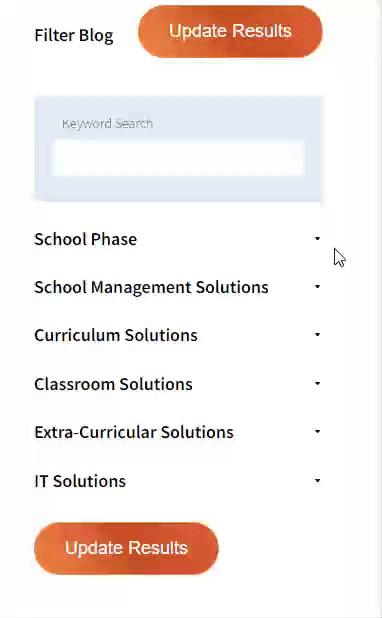


Our team sorts through all blog submissions to place them in the categories they fit the most - meaning it's never been simpler to gain advice and new knowledge for topics most important for you. This is why we have created this straight-forward guide to help you navigate our system.


And there you have it! Now your collection of blogs are catered to your chosen topics and are ready for you to explore. Plus, if you frequently return to the same categories you can bookmark your current URL and we will save your choices on return. Happy Reading!
Parents and peers often complain that students spend too much time sitting around, scrolling on their phones, just looking at pictures (posts) and videos (reels) on Instagram. However, in the right context, social media can be a useful classroom tool. Especially when teaching about language and culture. Also, the teacher has a head-start as their lesson will be using a tool that the students are already invested in.

There are many ways to approach this type of lesson. It can take the form of a Search, Create or Explore exercise.
This exercise takes place entirely in the classroom. The teacher can initiate a conversation on monuments or historical sites in the students’ countries. Then one at a time each student tells the class what monument interests them, and the rest of the class looks it up on Instagram. This will give the students an insight into different aspects of a cultural site. It also gives the students an opportunity to highlight interesting tourist destinations such as the Nazca Lines in Peru. The fact that a fellow student has selected a site immediately creates interest in the class as they are interested in each other’s interests and opinions socially. The teacher will have a great opportunity to both talk about culture and introduce the students to a wide selection of vocabulary.
This type of exercise encourages students to create their own Instagram posts. This will surely gain the students’ immediate attention and dedication as it is all about them. It gives them a space to express themselves and their personalities. To implement this exercise the students are given a pre-selected monument or site to go to, for example, a historic church or university in the city. The students go to the site and are allowed to take Instagram photos of themselves around the area, and using their smartphone skills they will come back with a lot of interesting results. Now, everyone knows what students are like, so not only will the posts be about the specific monument, but they will also be about themselves having fun. This guarantees a lot of interesting and fun posts, also when they are participating actively in creating the material for a lesson they can take ownership of the results. The teacher can use this type of class to encourage narrative and storytelling among the students. Also, they can compare their results and see the monument from each other’s perspective.
Students can also use the explore method. This, out of all the others, maximizes the students’ creativity. The students are told to go out and explore and make posts about anything interesting in the area. It can be a restaurant, an obscure statue, a craft fair, or anything that sparks their interest. Later, all the students show their posts and talk about where they went and what they saw. Of course, the teacher should have local knowledge to provide background information. This is a great way of learning about the culture of a city and will lead to interesting conversations and create familiarity with the locality. It will probably also lead to lots of follow-up posts by the students as they explore each other’s local haunts.
These are just three methods of using Instagram in a classroom scenario. Of course, with the proper organization, this type of class could also be done remotely, it would only require the teacher and the students to be able to see the participants’ Instagram profiles. That way the teacher could refer to a post by a student and everyone would look at it and understand it within the context of the lesson.
Students spend a lot of time on Instagram, and so do a lot of teachers. So instead of bemoaning this ubiquitous application why not use it as a teaching tool? The students are already interested, the teachers are probably on it already and it is likely the school has a profile to create business. If everyone is using it outside and around the class, isn’t it time it became part of the lesson?

The author

Read more

Read more

Read more

Read more

Read more

Read more

Read more

Read more


Are you looking for solutions? Let us help fund them! Nexus Education is a community of over 11,000 schools that come together to share best practise, ideas and CPD via online channels and free to attend events. Nexus also offers funding to all school groups in the UK via nexus-education.com


Established in 2011, One Education is a company at the heart of the education world, supporting over 600 schools and academies. Our unique appeal as a provider is in the breadth and synergy of the services we offer, supporting school leaders, teachers and support staff to achieve the best possible outcomes for their pupils and staff.

School Space is a social enterprise that has empowered schools for over 12 years through their profitable and hassle-free lettings services. So far, they’ve generated over £5 million in revenue for education, helping to connect over 200 schools with their local communities.


Unify is an online sales and marketing tool that allows users to create tailored personalised documents in moments.


There’s nothing special about the energy we sell. In fact, it’s exactly the same energy as all our competitors provide. But there is something special about the way we do it. Where others complicate the process, we simplify it. Where others confuse customers with hidden terms, we’re an open book. And where others do all they can to make as much money from their customers as possible, we do all we can to make as little. Everything we do, we do it differently. Our customers are a privilege. One we’ll never take advantage of.


Securus provide market-leading monitoring solutions to safeguard students on ALL devices both online and offline. We also offer a full monitoring service, where we carry out the monitoring on behalf of the school, freeing up valuable staff resources. From the smallest school to large MAT groups, Securus offers safeguarding protection for all!


Bodet Time offers dedicated solutions to education through lockdown alerts, class change systems, PA and synchronised clock systems. Improving time efficiency of the working and school day; ensuring safety through lockdown alerts; increasing communication with customised broadcast alerts.


Robotical makes Marty the Robot - a walking, dancing coding robot that makes programming fun and engaging for learners as young as 5. Our robots come with a full Learning Platform that has complete teaching resources, to make lesson planning a breeze.